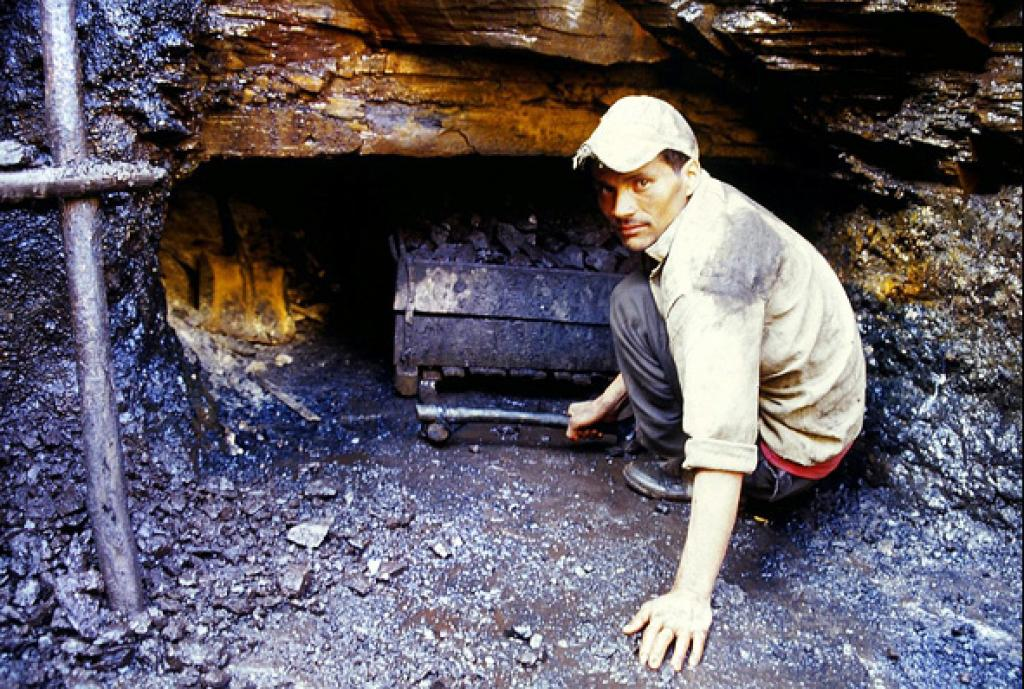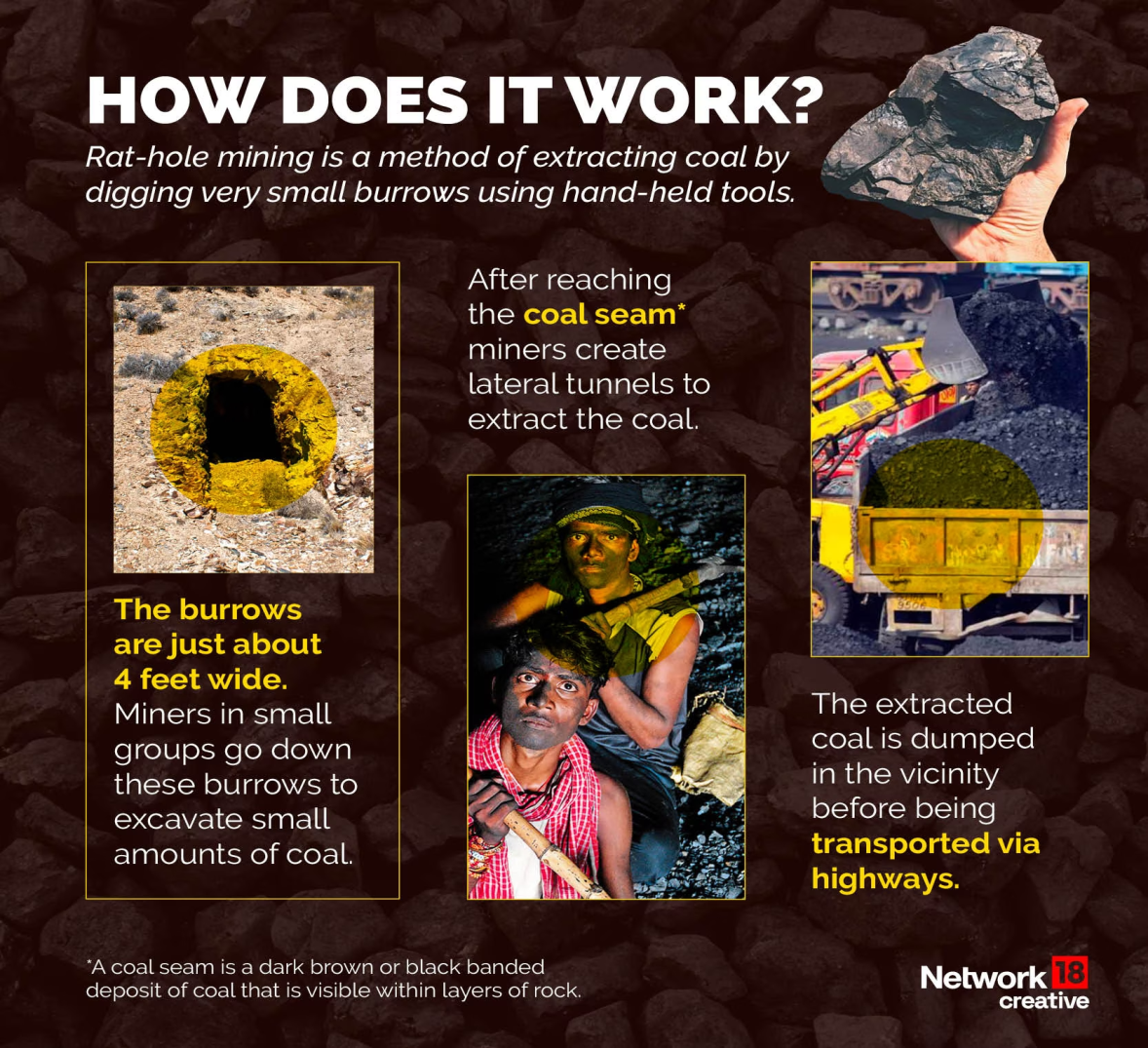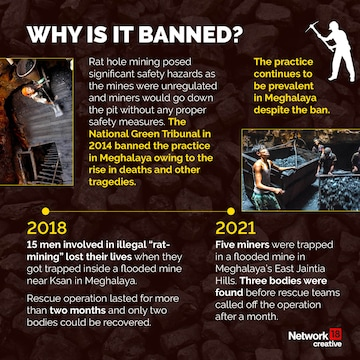Description

Copyright infringement not intended
Picture Courtesy: https://www.downtoearth.org.in/news/mining/the-unregulated-lethal-and-corrupt-world-of-meghalaya-s-rat-hole-mines-62507
Context: The efforts of the Justice Brojendra Prasad Katakey committee to tackle Meghalaya's environmental issues stemming from rat-hole coal mining involve addressing several intricate challenges.
Details
- Justice Katakey was appointed by the High Court of Meghalaya to investigate and recommend measures for environmental restoration following the ban on rat-hole coal mining. His role involves overseeing compliance with directives from higher courts, including the Supreme Court and the National Green Tribunal.
Issues Identified by the Katakey Committee
- Lack of Progress: The committee has flagged the slow progress in restoring the environment damaged by past mining activities.
- Acid Mine Drainage: Ongoing acid mine drainage from abandoned pits is causing environmental contamination and health risks to nearby communities.
Restoration Efforts and Recommendations
- Utilization of Environmental Funds: The committee highlights the non-utilization of the Meghalaya Environment Protection and Restoration Fund (MEPRF) for restoration projects.
- Closure of Abandoned Pits: One of the recommendations is to prioritize the closure of abandoned mine pits to mitigate ongoing environmental hazards.
- Coal Usage Audit: A thorough audit of coal usage is underway to ensure compliance with regulations and royalty payments by industrial consumers.
Rat-hole coal mining
- Rat-hole coal mining, a practice banned in many countries due to its dangers and environmental impact, is a desperate attempt to extract coal at a terrible cost.
|
Rat-hole mining has been a subject of regulatory scrutiny and legal challenges due to its hazardous nature and environmental impacts. In India, the National Green Tribunal (NGT) banned rat-hole coal mining in Meghalaya in 2014 due to its adverse effects on the environment and safety hazards for miners.
|
The Process
- Site Selection: Miners, often working independently or in small groups, identify a location on a hillside believed to contain coal deposits. This selection process often involves minimal geological expertise, increasing the risk of accidents due to unstable terrain.
- Digging the Rat-Holes: The defining characteristic of this method is the creation of narrow tunnels, just wide enough for a person to squeeze through. These tunnels, often referred to as "rat-holes," are dug vertically into the hillside using basic tools like pickaxes and shovels. The depth of these tunnels can vary significantly, ranging from a few meters to tens of meters depending on the location of the coal seam.
- Extracting the Coal: Once the vertical shaft reaches the coal seam, miners crawl through the narrow tunnel to access the coal deposit. Working in cramped and poorly ventilated conditions, they extract coal manually using basic tools like hammers and chisels. The extracted coal is then broken into smaller pieces to facilitate transportation through the narrow tunnels

Environmental Impact
- Deforestation: Establishing these mines often involves clearing vegetation from hillsides, leading to deforestation and habitat loss for wildlife.
- Erosion: The very act of digging these mines disrupts the natural stability of hillsides. Deforestation to clear space for mining removes vegetation that holds the soil in place. This combination makes the area highly susceptible to erosion by wind and rain. The loose soil washes away, causing landslides and silting up waterways.
- Water Pollution: Abandoned mines often fill with rainwater. This water becomes acidic due to contact with exposed coal seams, creating a phenomenon known as "acid mine drainage." This acidic water pollutes nearby streams, rivers, and groundwater sources.
- Soil Degradation: The acidic runoff from mines not only pollutes water but also affects the surrounding soil. The acidity reduces soil fertility, making it unsuitable for agriculture and hindering the growth of vegetation. This further disrupts the natural ecosystem and contributes to land degradation.
- Biodiversity Loss: Rat-hole mining often takes place in ecologically sensitive areas. The deforestation and habitat destruction associated with this practice disrupt ecosystems and displace wildlife. This can lead to a decline in biodiversity, impacting the entire food chain.
Health and Safety Concerns
- Unsafe Working Conditions: The most immediate danger is faced by the miners themselves. The narrow tunnels lack proper support structures, making them prone to collapse. This can trap or injure miners. Additionally, the poor ventilation within the tunnels creates a risk of suffocation due to a lack of oxygen or exposure to harmful gases like carbon monoxide.
- Respiratory Issues: Long-term exposure to coal dust while working underground can lead to serious respiratory problems, including black lung disease. This debilitating condition can significantly reduce a miner's lung function and make it difficult to breathe.
- Community Health: Communities residing near these mines are also at risk. The air and water pollution caused by acid mine drainage can have a detrimental impact on their health. Exposure to contaminated water can lead to various health problems while breathing in polluted air can cause respiratory issues. The livelihood of these communities may also be affected by the decline in water quality and the loss of fertile land.
Regulatory Framework
- National Green Tribunal (NGT): In 2014, the NGT, a body established to handle environmental disputes, issued a critical ban on rat-hole coal mining. This ban recognized the severe environmental hazards associated with this practice and aimed to protect the environment and people's health.
- State Regulations: Many states, including Meghalaya, a region notorious for rat-hole mining, have their own laws and regulations prohibiting unauthorized mining practices. However, enforcement of these regulations can be challenging due to factors like:
- Limited Resources: State governments may not have the manpower or resources required for effective monitoring and enforcement in remote mining areas.
- Corruption: In some cases, corruption can hinder proper enforcement, allowing illegal mining to continue despite regulations.

Social and Economic Context
- Livelihoods: For many local communities, particularly those residing in poverty-stricken regions, rat-hole coal mining, despite its dangers, provides a source of income. The lack of formal education and alternative employment opportunities can force people to resort to this dangerous practice to make ends meet.
- Poverty and Informal Economy: Rat-hole mining often thrives in regions with limited economic development and a high prevalence of poverty. The lack of formal job opportunities pushes people towards the informal economy, where mining becomes a means of survival even if it's dangerous.
- Child Labour: Children, due to their smaller size, can navigate the narrow tunnels more easily, making them vulnerable targets for exploitation.
The Challenge of Balancing Livelihoods and Environmental Protection:
- The regulatory framework, while crucial for protecting the environment, faces challenges due to the socio-economic context. A complete shutdown of rat-hole mining without addressing the underlying issues of poverty and lack of alternative employment can create further hardship for these communities.
Potential Solutions:
- Sustainable Livelihood Programs: Investing in skill development programs and creating alternative income sources like eco-tourism or sustainable agriculture can offer people viable options beyond dangerous mining practices.
- Stricter Enforcement: Strengthening enforcement of existing regulations with adequate resources and addressing potential corruption can deter illegal mining activities.
- Community Outreach: Raising awareness about the dangers of rat-hole mining and the long-term environmental damage it causes within affected communities is crucial.
Conclusion
- Eradicating rat-hole coal mining requires a multi-pronged approach. Effective regulations combined with social development initiatives that address poverty and provide alternative livelihoods are essential. Raising public awareness and fostering community engagement can play a significant role in achieving sustainable and environmentally friendly practices.
Source:
THE HINDU
WIKIPEDIA
|
PRACTICE QUESTION
Q. Rat-hole mining is a vital source of income for many households in certain regions, however, it is certainly unsafe and environmentally damaging. Consider the socioeconomic aspects involved and provide a viable approach that transforms these communities away from rat-hole mining while ensuring their well-being.
|
















